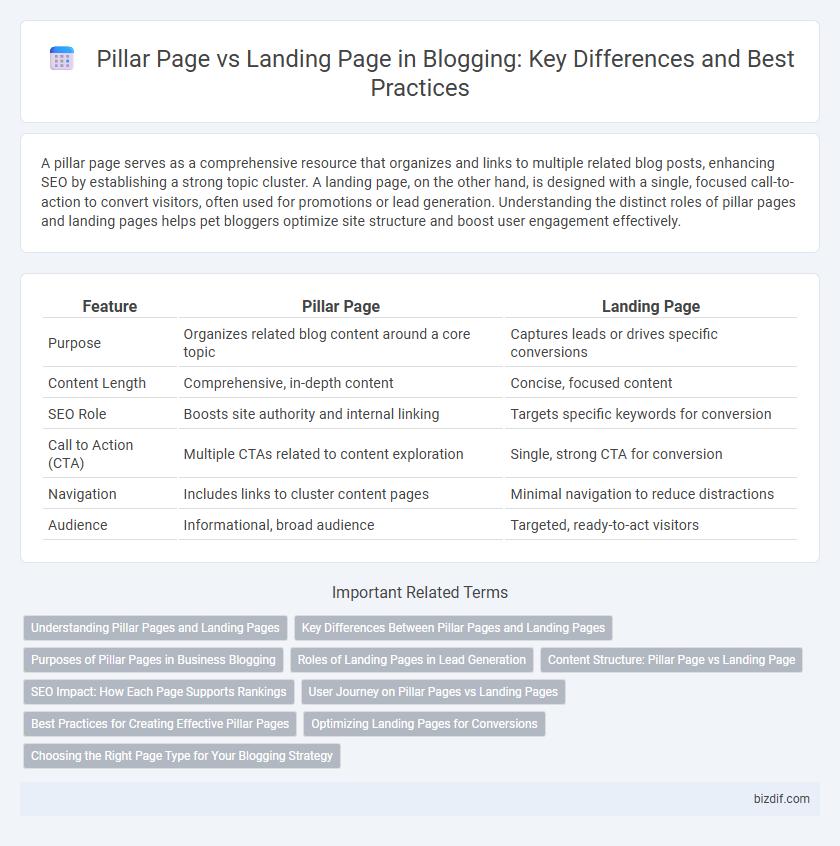A pillar page serves as a comprehensive resource that organizes and links to multiple related blog posts, enhancing SEO by establishing a strong topic cluster. A landing page, on the other hand, is designed with a single, focused call-to-action to convert visitors, often used for promotions or lead generation. Understanding the distinct roles of pillar pages and landing pages helps pet bloggers optimize site structure and boost user engagement effectively.
Table of Comparison
| Feature | Pillar Page | Landing Page |
|---|---|---|
| Purpose | Organizes related blog content around a core topic | Captures leads or drives specific conversions |
| Content Length | Comprehensive, in-depth content | Concise, focused content |
| SEO Role | Boosts site authority and internal linking | Targets specific keywords for conversion |
| Call to Action (CTA) | Multiple CTAs related to content exploration | Single, strong CTA for conversion |
| Navigation | Includes links to cluster content pages | Minimal navigation to reduce distractions |
| Audience | Informational, broad audience | Targeted, ready-to-act visitors |
Understanding Pillar Pages and Landing Pages
Pillar pages serve as comprehensive hubs that cover a core topic in depth, organizing related content to improve SEO by enhancing topical authority and internal linking structure. Landing pages are designed specifically for conversion, targeting a single goal such as lead generation or sales, with focused messaging and a clear call-to-action. Understanding these differences helps marketers strategically use pillar pages for content organization and landing pages to capture and convert traffic effectively.
Key Differences Between Pillar Pages and Landing Pages
Pillar pages serve as comprehensive hubs covering broad topics with multiple linked subtopics, enhancing SEO by organizing content around key themes. Landing pages are designed for specific conversions, focusing on a singular call-to-action such as sign-ups or sales, with minimal distractions. Unlike pillar pages, landing pages prioritize concise messaging and direct user engagement to drive targeted campaign results.
Purposes of Pillar Pages in Business Blogging
Pillar pages serve as comprehensive hubs that organize and link related blog content, enhancing site structure and improving SEO by targeting broad keyword themes. They establish authority on core topics, helping businesses attract and engage a wider audience through in-depth, valuable information. By boosting organic traffic and facilitating user navigation, pillar pages drive long-term growth and lead generation in business blogging strategies.
Roles of Landing Pages in Lead Generation
Landing pages are designed to capture leads by focusing visitor attention on a single call-to-action, such as form submissions or product sign-ups. They play a crucial role in lead generation by converting traffic from marketing campaigns into actionable contacts through targeted messaging and simplified navigation. Optimizing landing pages for user experience and relevance significantly increases conversion rates and drives business growth.
Content Structure: Pillar Page vs Landing Page
A Pillar Page features a comprehensive, in-depth structure that covers broad topics with multiple linked subtopics, enhancing SEO by organizing content hierarchically and improving user navigation. In contrast, a Landing Page is designed with a focused, single-purpose layout aimed at driving specific conversions, often containing minimal navigation to maintain visitor attention. This difference in content structure directly impacts user engagement and search engine rankings, with Pillar Pages supporting long-tail keyword strategies and Landing Pages targeting precise campaign goals.
SEO Impact: How Each Page Supports Rankings
Pillar pages enhance SEO rankings by organizing extensive content around a central topic, improving site structure and keyword relevance while boosting internal linking. Landing pages focus on conversion-driven content tailored to specific user intents, optimizing for targeted keywords to increase click-through rates and reduce bounce rates. Combining pillar and landing pages creates a balanced SEO strategy that drives organic traffic and nurtures leads effectively.
User Journey on Pillar Pages vs Landing Pages
Pillar pages guide users through comprehensive topics by organizing content clusters that enhance navigation and engagement across multiple subtopics, fostering a deeper understanding and longer site visits. Landing pages concentrate on specific user actions with focused messaging and clear calls-to-action, designed to convert visitors promptly at targeted stages of the buyer journey. Optimizing the user journey on pillar pages involves nurturing exploration and education, while landing pages drive immediate conversions through streamlined, goal-oriented design.
Best Practices for Creating Effective Pillar Pages
Effective pillar pages are comprehensive, well-structured hubs that organize related content around a broad topic, improving SEO by targeting high-value keywords and enhancing user experience. Best practices include using clear headings, integrating internal links to cluster content, and incorporating rich media like images and videos to increase engagement. Optimizing load speed and ensuring mobile responsiveness further boost the pillar page's performance and ranking potential.
Optimizing Landing Pages for Conversions
Optimizing landing pages for conversions involves focusing on clear calls-to-action, fast loading times, and tailored content that aligns with specific user intents. Unlike pillar pages, which provide comprehensive information and support SEO through internal linking, landing pages are designed for direct conversion by minimizing distractions and emphasizing value propositions. Implementing A/B testing and leveraging analytics data further enhances the effectiveness of landing pages in increasing lead generation and sales.
Choosing the Right Page Type for Your Blogging Strategy
Pillar pages serve as comprehensive resources that organize content around core topics, boosting SEO by linking related blog posts and enhancing site authority. Landing pages concentrate on conversion goals, such as capturing leads or promoting offers, with focused calls-to-action and minimal distractions. Choose pillar pages to build topic authority and improve organic traffic, while selecting landing pages to drive specific user actions and increase conversion rates.
Pillar Page vs Landing Page Infographic

 bizdif.com
bizdif.com